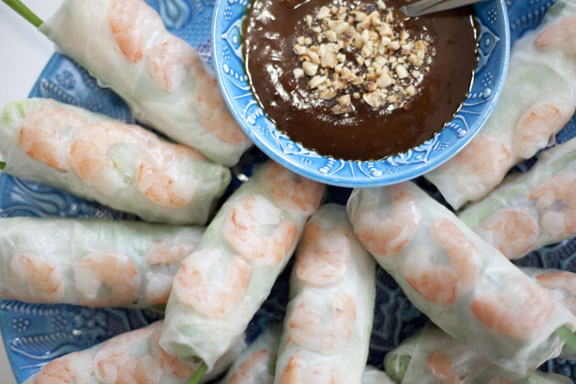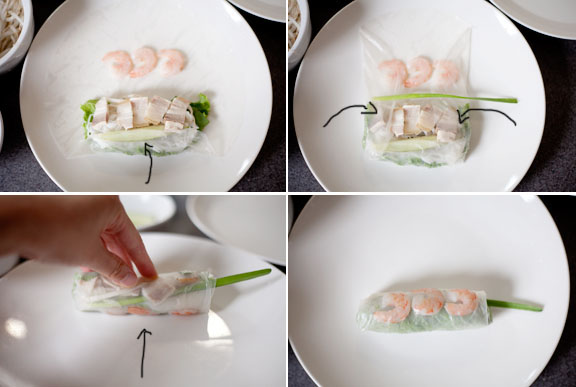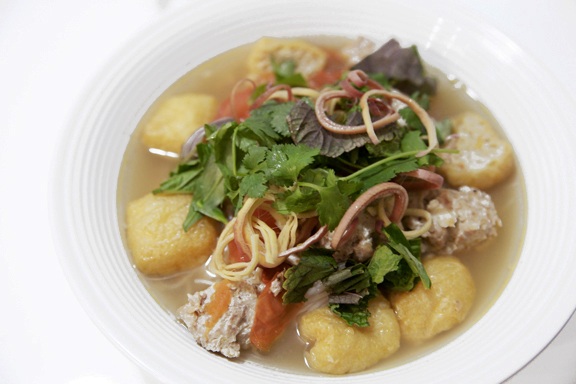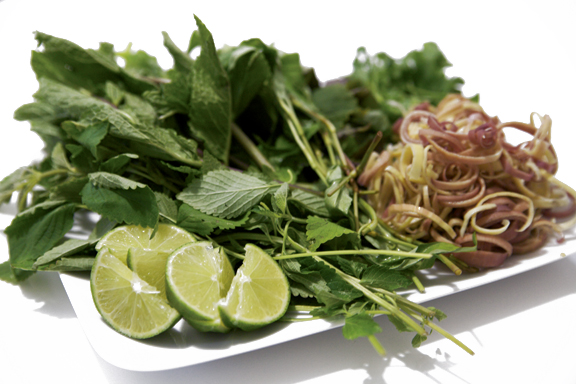Whether you call them Vietnamese summer rolls or fresh spring rolls or “salad rolls” (which is the direct translation of goi cuon), variations on these tasty bites are wildly popular these days. I see versions at all kinds of restaurants, in magazines, on blogs, and at potlucks and dinner parties, where they are often a hit among guests. I suspect the popularity is due in no small part to how good something so healthy can taste, as well as to its adaptability to whatever ingredients you have on hand.
I always took for granted how easy these are to make, but over the years I’ve been surprised (and sometimes a little appalled, I confess) at all the ways these can go wrong, from people soaking the rice paper in water until it turns into a soggy mess, to putting the finished rolls in the refrigerator until the rice paper turns tough. I am, admittedly, a little OCD in general, and even more so when it comes to particular foods. But someone might as well benefit from my obsessive tendencies, right? So here I give you my slightly OCD recipe for making classic Vietnamese summer rolls, which includes pork and shrimp. I hope you’ll find it worth your time! :)
This post is a submission to this month’s Delicious Vietnam, a monthly food blogging event started by A Food Lover’s Journey and Ravenous Couple, and hosted this month by Phuoc’n’delicious.
Vietnamese Summer Rolls (Goi Cuon)
Makes 12 rolls
Serves 4-6 as an appetizer
Summer rolls can be as easy or complicated as you want, but the better your individual ingredients, the better the roll. You want good rice paper that will retain some stretch. Bad-quality rice paper can not only tear while wrapping but sometimes even disintegrate in your fingers while you’re eating. I find that the Rose brand rice paper is usually reliable and more readily available (I’ve even found it in the ethnic aisles of everyday supermarkets). (See Viet World Kitchen for a fuller discussion on rice paper brands.) Some of the work can be cut down if you purchase pre-cooked, pre-shelled shrimp, but since those are often frozen, I find that their sometimes rubbery taste can ruin a roll. I also prefer to briefly cure my pork and then roast it in the oven (I use a toaster oven), which gives it a nice salty taste with some caramelized bits. Grilling the pork works as well, as does microwaving it if you’re in a hurry. My family usually uses pork belly or some kind of semi-fatty cut, but you can also use lean pork. Whatever the cut and cooking method, I’ve found that curing helps bring out the flavor of the meat.
The other key to a good roll is in how you wrap it. The rice paper should be properly moistened and topped with enough ingredients as to make a full, plump roll but not so much as to cause bursting or tearing. The thickness should be bite-size (not burrito-size!). The roll should also be wrapped tightly, so that the ingredients are not falling out as you eat it. And, finally, the rolls should have a consistent size, shape, and look if you are presenting them together on a dish.
When I serve these as an appetizer, I wrap the rolls a couple hours ahead of time, cover them with a damp cloth, and keep them at room temperature until they’re ready to be served. To complete the meal, I often serve these along with vermicelli noodle bowls, since many of the ingredients overlap. For a family-style meal, I prepare all the ingredients and let everyone wrap their own rolls at the table. In that case, I often make extra noodles so people have the option of assembling their own noodle bowls in addition to making rolls. Because the prep work can be rather involved, when I’m using this as a weekday meal, I’ll often make enough of everything for several meals and keep the leftover vegetables, meat, and noodles in the fridge overnight. The noodles will need to be reheated in the microwave to soften them up again, and the rice paper should only be moistened just before wrapping.
1/2 lb pork (as lean or fatty as you like)
2 Tbsp kosher salt
1/2 lb shrimp
6 oz. thin round rice noodles (also called vermicelli noodles)
4-6 lettuce leaves, whole (choose lettuce with soft leaves such as green, red, or butter lettuce)
2 cups Vietnamese herbs, such as mint, cilantro, fish mint, perilla, and Vietnamese coriander
1 cup bean sprouts
1/2 cucumber
12 sheets rice paper, plus a few extra in case any tear
a few sprigs of Chinese chives (optional)
peanut sauce (recipe follows)
1. Rinse the pork in cold water and pat dry with a paper towel. If working with one large chunk of meat, you might want to cut it into a couple pieces to help it cure more evenly and cook more quickly later (you’ll eventually be cutting the meat into small slices). To cure the pork, cover it liberally in salt (about 2 Tbsp or more — it will be rinsed off before cooking) and let it sit at room temperature for an hour or more while you prepare the other ingredients.
2. Clean and devein the shrimp. If you choose to take the shells off (to make deveining easier), reserve the shells to cook along with the shrimp in order to get a fuller stock. In a small sauce pan, boil about 1 1/2 to 2 cups of water (or just enough to later cover the shrimp). When the water comes to a boil, add the shrimp (and the reserved shells if they were taken off earlier). If there’s too much water, pour a bit out so that the shrimp is only just covered. Let the shrimp cook 2-3 minutes or until they just turn opaque. Take the shrimp out, peel, and slice in half lengthwise (slicing it this way will make them less bulky when wrapping). At this point, you can toss the shrimp shells back into the sauce pan and let the liquid continue to simmer to get a more concentrated stock. Reserve the shrimp stock for making the peanut sauce or for another use.
3. Boil a pot of water. Add the thin round rice noodles and cook 3-5 minutes or until al dente. Set an overturned bowl into a colander and drain the cooked noodles into the colander and over the inverted bowl, which will help the noodles not clump together. Rinse the noodles under cold water. This will stop the cooking, get rid of excess starch, and prevent sticking.
4. When the pork has cured for long enough, rinse off all the salt and pat dry. Roast in oven or toaster oven at 375°F for about 30 minutes. Let the meat cool, then cut into thin slices. Reserve any juices or pan drippings for making the dipping sauce later.
5. Wash and drain the lettuce, herbs, and bean sprouts. Wash the cucumber and cut into thin spears about 3 inches long.
6. Prepare your mise en place: Set the shrimp, pork, noodles, cucumber, lettuce, herbs, chives (if using), and bean sprouts into bowls or on a large platter. Fill a deep plate or wide bowl (a pie plate works well) with warm water. Set out the dry rice paper, a large plate for wrapping, and platter on which to set the wrapped rolls. Dampen a small kitchen towel or washcloth with warm water and wring it out well — you want it to be just a little damp but not dripping wet or it will ruin the rice paper. You’ll use this to cover the prepared rolls so that they don’t dry out before you serve them.
7. Moisten a sheet of rice paper by briefly dipping it into the plate or bowl of warm water, making sure that the entire surface is moistened. Shake off any excess water. Do not leave the rice paper in the water. The rice paper should still be stiff at this point, which allows you to lay it flat and smooth on your plate, where it will continue to soften. If you leave it in the water, it will become too soft to handle and will eventually turn wrinkled and soggy.

The rice paper on the left is too moist. Notice the haphazard wrinkling that results from the rice paper softening even before it was laid onto the plate. (If you wait too long, it will become difficult to even lay the paper flat onto the plate without it sticking to itself.) The rice paper on the right, however, has wrinkles that form an even gridding left over from the texture of the original dry rice paper and the way the paper gradually expanded on the plate after moistening. It still has some cling to it, as can be seen in the way it sticks to the plate. It is pliable but still has stretch.
8. Setting up the roll: You generally want to lay the ingredients out to be the length that you want your finished roll (about 5 inches is a good length). Keep an eye on the amount and proportion of ingredients as you arrange them, so that you end up with a full but not bursting roll. I also like to arrange the components of my roll in a certain order so as to provide a soft cushioning for the harder ingredients, otherwise things like bean sprouts may stick out and puncture the rice paper. Start by laying the moistened rice paper flat onto the large plate. Tear off a small piece of lettuce and set it on the lower third of the rice paper, centered (see photo below). (The leaves are soft and easy to use, but you can also use the stem too — I just crack the stem all over with my fingers so that it becomes soft enough to roll.) Using the lettuce as a base, add as few or as many herb leaves as you like. Arrange some vermicelli noodles into a stretched-out nest on top of the lettuce and herbs. Nestle a spear of cucumber, a couple bean sprouts, and a few slices of pork into the noodles. Arrange three pieces of shrimp (that have been sliced lengthwise) cut-side up on the top third of the rice paper, centered (see photo below) — this way, the outer part of the shrimp will show through when rolled.
9. Rolling: By the time you’ve arranged all the components of your roll onto the sheet of rice paper, the rice paper should be soft enough to handle but still be sticky and have some stretch to it. If there are any dry spots, just dab a bit of water with your fingers there and allow to soften. When ready, first fold the bottom of the rice paper up over the nest of ingredients. Then fold in the two sides. At this point, if using chives, tear off a piece about 1-2 inches longer than your roll and set it over the two folded-in sides and just above the other ingredients, leaving 1-2 inches of the chive sprig sticking out one side of the roll. (Some people fold the two sides in first and then fold over the bottom, stick in a sprig of chive, and continue to roll up — either way works.) Now comes the important part — as you roll, the ingredients will start to shift, so keep your fingers spread out across the length of the roll, pressing down and tucking things into place as you roll from the bottom up. If you’ve rolled sushi or, yes, burritos, it’s the same challenge of keeping the ingredients in a tight, neat bundle. Set the finished roll onto a serving platter and cover with the damp cloth.
10. Repeat steps 7-9 until all rolls are complete. Rolls should be kept at room temperature and eaten within a few hours. It is best not put the rolls in the fridge, as the rice paper will thicken and harden.
Peanut Sauce
Makes about 1 cup
This is the more common peanut dipping sauce served in restaurants, not the traditional Vietnamese nuoc leo dipping sauce, which uses minced pork liver instead of peanut butter.
1 tbsp oil
2 cloves garlic, minced
1 tsp chili paste
1/4 cup hoisin sauce
1/2 tsp sugar
2 Tbsp peanut butter
1/4 cup shrimp stock and/or pork drippings from goi cuon recipe above, or water
toasted peanuts, crushed
Heat oil in a small sauce pan over medium-high heat. Add minced garlic, and when it begins to turn golden, add the chili paste, hoisin sauce, sugar, peanut butter, and shrimp and pork juices. Stir until the peanut butter has dissolved and mixture is well blended. Adjust the thickness of the sauce by adding more peanut butter to thicken or more stock to thin out.
In a small skillet, toast a handful of raw peanuts over medium heat until they turn golden. Crush peanuts with a mortar and pestle or chop with a knife. Sprinkle crushed toasted peanuts over the sauce before serving.






















Connect with us